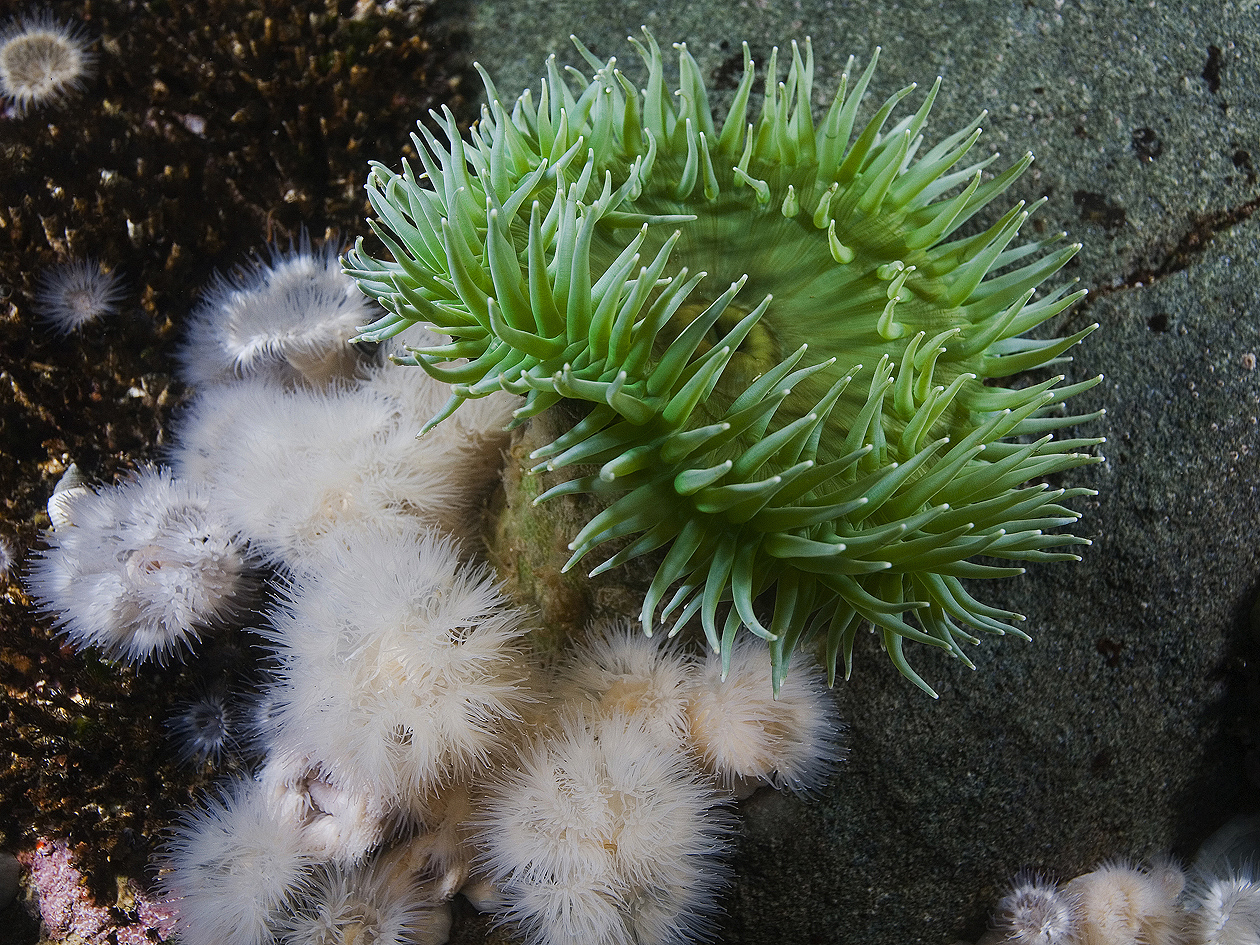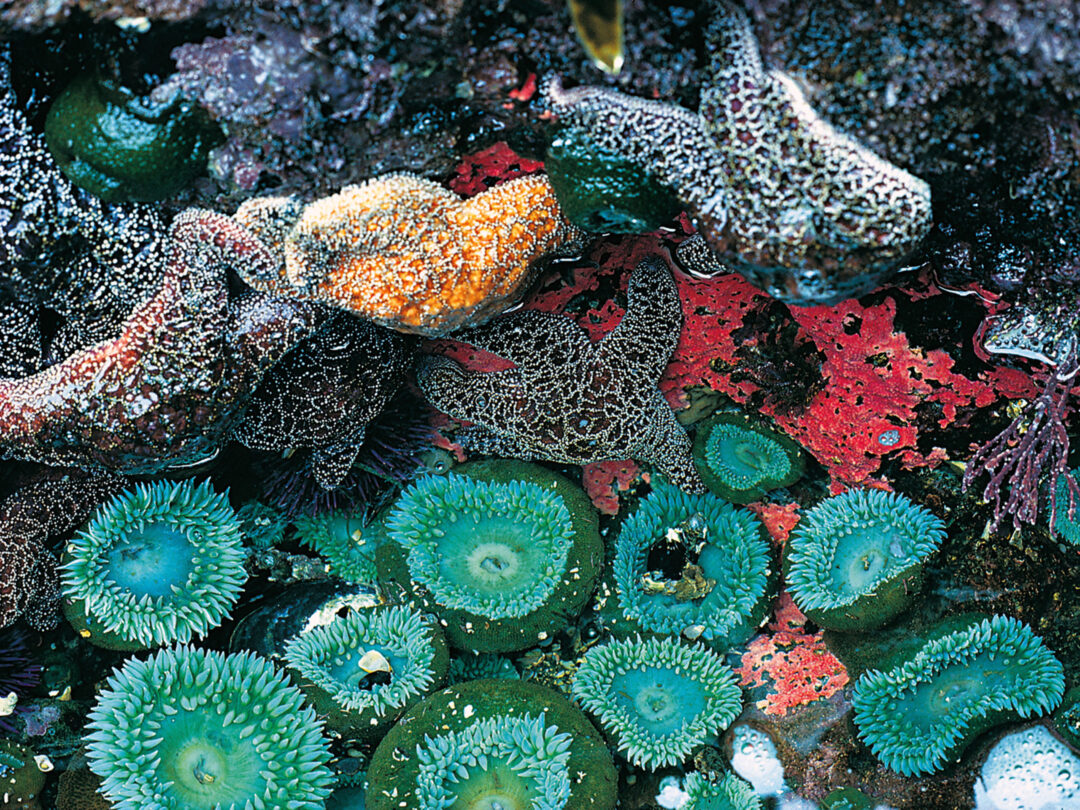Carnivorous and always hungry, sea anemones are not plants, as some people might think, but silent slow-motion predators that will devour any small animal careless enough to stray within reach of their deadly tentacles. Equipped with tiny poisonous harpoons and digestive enzymes so strong they can digest the flesh of a small animal in 15 minutes, the sea anemone belies its harmless appearance.
One of the places I so loved visiting during our years living on Vancouver Island was Botanical Beach in Port Renfrew where the tidal pools presented me the unique opportunity to have access to these guys at close range.
Sea anemones are animals belonging to the phylum Cnidaria, which includes the jellyfish, corals and sea pens. They live in all oceans from the shore to a depth of 10,000 metres, and range in size from one centimetre to almost two metres in diameter. They attach themselves to rocks, wharves and other hard surfaces, or burrow in mud and sand.
Sea anemones have a flat upper surface, with a central mouth surrounded by tentacles, a tubular body, and a flat base that attaches to the substrate.

A sea anemone uses its tentacles to capture prey and defend itself against predators. Every tentacle is covered with thousands of tiny stinging capsules called nematocysts. Each nematocyst contains a coiled hollow tubule. Some tubules carry a minute amount of poison capable of paralysing or killing small animals. When a small fish, shrimp or crab comes into contact with the tentacles, hundreds of these capsules open to fire their barbed tubules like harpoons. They may pierce the skin of the animal and inject their poison.
The tubule remains attached to the tentacle so, like a harpooned whale, the victim is held by its captor. The anemone moves all the nearby tentacles into position to sting and hold its prey until it is subdued by the poison. It then moves the prey to its mouth and swallows it whole. Later, it spits out any nondigestible parts, such as bones and shells. Although some tropical species can inflict painful stings, none of British Columbia’s anemones are poisonous to humans.
Sea anemones have no visible sense organs, but they can distinguish between edible and inedible items. If you were to drop a piece of paper onto its tentacles, a sea anemone would grasp but then discard it. But if you first soaked the paper in clam juice, the anemone would grasp, then swallow the paper, because it tastes like food.

One kind of British Columbia sea anemone can use its poisonous stings against its own kind in competition for territory. It possesses special clublike structures, packed with potent nematocysts, that it uses to battle other anemones. Territorial fights often result in serious injury and even death to one or both anemones.
Some sea anemones can clone themselves–a useful trait when stuck to a rock with no members of the opposite sex nearby. An individual of some species can break off a small part of its base, which then grows into an adult anemone. An individual of others seems to crawl in two directions at once and slowly tear itself in half lengthwise. Both of these methods result in two genetically identical animals where once there was one.
A small intertidal anemone known as Anthopleura elegantissima is a master of cloning. A single anemone can create large aggregations of genetically identical anemones. As the clone expands, it may run into another clone of different genetic makeup. When one clone encroaches on the territory of another, the anemones on the periphery engage in battle using bulbous clubs full of nematocysts to sting the encroaching anemones. The anemones keep stinging each other until one draws away or dies. Considerable injury may be inflicted on members of both clones, and eventually, the clones establish a narrow band of bare rock between them. Encroachment by either clone into this no anemone’s land results in more fighting. So really, not very good neighbours.
Many species of sea anemones inhabit rocky shores, especially where there are tide pools in which they can remain submerged when the tide goes out. Most anemones attached to rocks left high and dry at low tide are in crevices or on the underside of rocks where it stays cool and wet. Anemones out of water generally have their tentacles retracted into their bodies to prevent drying, and may appear to be little more than wet, squishy lumps. Botanical Beach is a particularly good access spot.
Sea anemones are among the most colourful marine animals in British Columbia, occurring in many shades of red, green, white, orange and pink. When they are seen in large, colourful clusters, it is easy to understand why people sometimes mistake them for flowers.
For more photos on our visits to Botanical Beach, click here >





No Comments